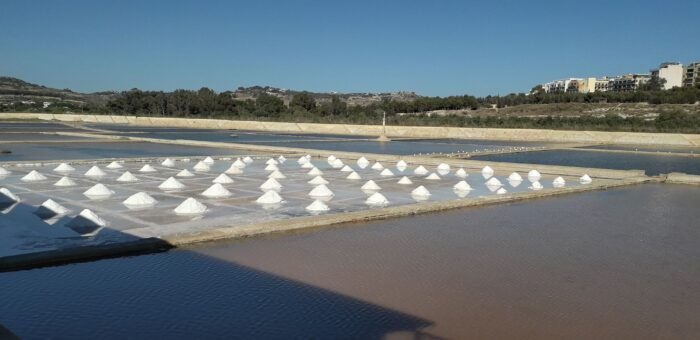As its name implies, Salina Nature Reserve is inextricably linked to salt production, and this has been so for many centuries. Pictorial records exist in the paintings depicting scenes of the Great Siege of 1565 where salt pans are shown where the present salt pans of the reserve are situated today. However, they are clearly very different. The present salt pans were constructed just after the Great Siege and their plans are available and preserved at the national archives.
Such a massive investment was then more than justified considering that salt was worth its weight in gold! So much so, that the word “salary” traces its origin from the word sal being the word for salt in Latin. It is known that the soldiers of the Roman Army where sometimes paid with salt instead of money, with their monthly payment being called salarium.
Salt was produced at Salina ever since in large quantities till the eighties, a good season producing as much as 700 tons! The new management by BirdLife Malta has worked hard to bring the salt pans back to a state that salt can be produced once again using the original method intended by their architects. A careful examination of the mechanics of the salt pans shows that the site can be split into three functional areas: a filtration part, brine production and salt production.
On the seaward side, a large basin serves to tame the sea, allowing large waves to pass over its thick sea wall without trying to stop them as a breakwater would. This same basin captures whatever the sea and tempests churn from the bottom, being seaweed, sand and in modern times, a large amount of marine debris, mostly plastic items. Water is then channelled to a second large basin that is sheltered from the influence of sea waves and thus further sifts the water of suspended particles. From there, water is now under full control of a network of narrow canals that take sea water to any of the 33 inner salt pans.
The system is ingenious but simple. By opening or closing particular “water gates” in the canals, water is moved to wherever it is needed. All this is done without the use of any pumps, always relying on gravity as all the salt pans are always below sea level. Here, the original system was slightly modified to facilitate frequent adjustments to the flow of water. The old system was to insert two flat pieces of wood into matching slots carved in the stone of these “water gates” of the canals and clay is packed between them. This creates a watertight seal between the canal and the salt pan. The modifications made were limited to keeping the original wood and clay system but installing irrigation type valves going through the wood and clay. Therefore, with a simple twist of the valve, the water flow can now be regulated as opposed to the old system that only allowed an open or shut situation.
The inner salt pans come in two types, 10 are actual salt pans with a paved bottom, where salt is produced and the remaining 23 have a clay bottom and are intended to produce brine.
The cycle to produce salt starts in March or April after the bulk of the winter storms have come and gone, the salt pans earmarked for salt production are pumped dry and cleaned by hand, first with shovels and then power-washed spotless. This is vital to ensure that the end produce is of high quality. Then, a particular sequence of newly-installed water valves are opened and water is directed in from the sea, through the outer silt capture basins, through the distribution canals and into the clean salt pan, all by gravity. Once this salt pan is full, the valves are closed shut and the evaporation process starts. The brine pans are filled in a similar manner.
By June, salt starts crystallising, first in a thin crust, but by the end of the month a thick layer is clearly visible. Before the salt pan dries up completely, using shovels and a lot of elbow grease, the salt is heaped into mini pyramids and allowed to dry up even further for a couple of weeks. Now the salt is ready for harvest. Careful not to take the bottom layer of the salt which is still quite wet, the salt is now carried up into the salt storage barns and stored in large jumbo bags.
Whilst this allows the salt to breathe and dry further, dust and other contaminants are kept away from the salt. The process of flooding the salt pans is now repeated, this time taking brine from the brine pans. As this is already highly concentrated and in days, salt starts to crystallise, and the cycle continues. This can be repeated until the first rains that bring the salt production year to an end.
Modern international food standards are very rigorous, and salt has to undergo a detailed list of tests in specialised food laboratories before it can be offered for human consumption. In the coming weeks, we will be sending samples of the salt abroad for laboratory testing to confirm the quality. In the heyday of these salt pans, the salt produced in Malta was one of the best in the Mediterranean, and we hope that the results live up to that old standard! Based on the results, the salt will be packaged for sale.
By Manuel Mallia, Salina Nature Reserve Manager



